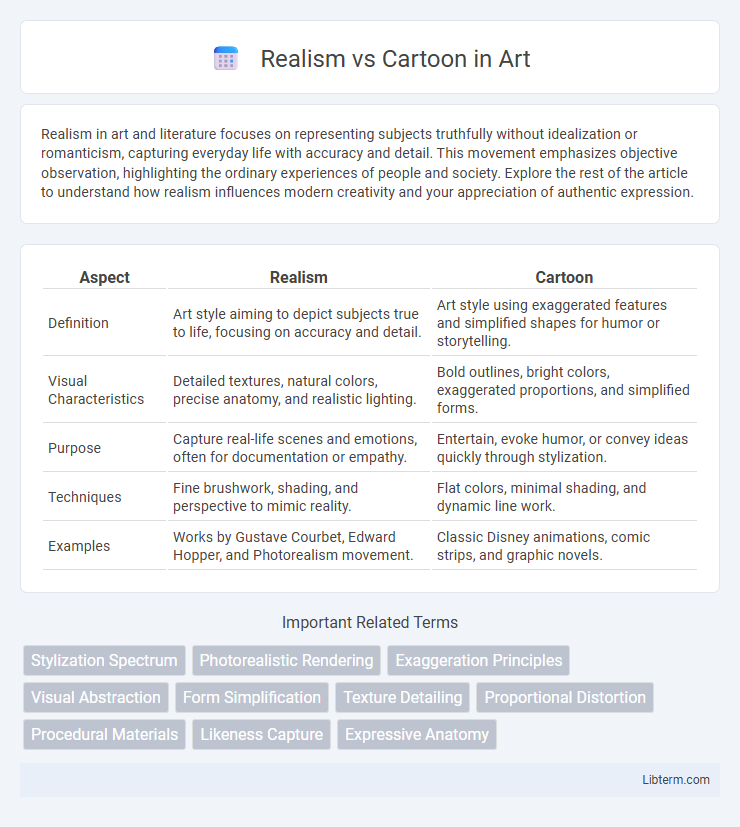Realism in art and literature focuses on representing subjects truthfully without idealization or romanticism, capturing everyday life with accuracy and detail. This movement emphasizes objective observation, highlighting the ordinary experiences of people and society. Explore the rest of the article to understand how realism influences modern creativity and your appreciation of authentic expression.
Table of Comparison
| Aspect | Realism | Cartoon |
|---|---|---|
| Definition | Art style aiming to depict subjects true to life, focusing on accuracy and detail. | Art style using exaggerated features and simplified shapes for humor or storytelling. |
| Visual Characteristics | Detailed textures, natural colors, precise anatomy, and realistic lighting. | Bold outlines, bright colors, exaggerated proportions, and simplified forms. |
| Purpose | Capture real-life scenes and emotions, often for documentation or empathy. | Entertain, evoke humor, or convey ideas quickly through stylization. |
| Techniques | Fine brushwork, shading, and perspective to mimic reality. | Flat colors, minimal shading, and dynamic line work. |
| Examples | Works by Gustave Courbet, Edward Hopper, and Photorealism movement. | Classic Disney animations, comic strips, and graphic novels. |
Introduction to Realism and Cartoon Styles
Realism in art strives to depict subjects with lifelike accuracy, emphasizing detailed textures, natural lighting, and proportional anatomy to create a believable representation. Cartoon styles prioritize exaggerated features, simplified forms, and bold colors, aiming to evoke emotion and convey stories with visual clarity and humor. Both styles serve distinct purposes: Realism captures authentic moments, while cartoons enhance expression and imagination.
Defining Features of Realism in Art
Realism in art is characterized by meticulous attention to detail, accurate depiction of light and shadow, and lifelike representation of subjects. This style emphasizes natural color palettes and precise anatomical proportions to create authentic scenes that reflect everyday life. Unlike cartoons, realism avoids exaggerated features or stylized forms, aiming to capture the true essence and complexity of the visual world.
Core Elements of Cartoon Aesthetics
Cartoon aesthetics emphasize exaggerated features, vibrant colors, and simplified shapes to create expressive and easily recognizable characters. Core elements include bold outlines, dynamic expressions, and stylized motion that prioritize emotional impact over anatomical accuracy. These components distinguish cartoons from realism by enhancing narrative clarity and visual appeal through artistic abstraction.
Historical Evolution of Realism vs Cartoon
The historical evolution of realism and cartoon art reflects distinct artistic purposes and techniques shaped over centuries. Realism emerged prominently in the mid-19th century as a reaction to romanticism, emphasizing accurate, detailed depictions of everyday life and social conditions, as seen in the works of Gustave Courbet and Jean-Francois Millet. In contrast, cartoons evolved from early satirical prints and political caricatures in the 18th century, developing into exaggerated, stylized forms used for humor, commentary, and mass communication, exemplified by pioneers like Thomas Nast and later animation studios such as Disney.
Visual Impact: Realism vs Cartoon Imagery
Realism imagery captivates viewers through intricate details, lifelike textures, and accurate lighting that create an immersive visual experience. Cartoon visuals emphasize bold lines, vibrant colors, and exaggerated expressions, producing a visually striking and easily recognizable style. Both approaches harness distinct visual elements to evoke emotional responses and enhance storytelling effectiveness.
Audience Perception and Emotional Response
Realism in visual media enhances audience immersion by portraying lifelike details that evoke genuine emotional responses and foster relatability. Cartoon styles utilize exaggerated features and simplified forms to amplify emotional expression and create a playful, approachable atmosphere, often eliciting humor or nostalgia. Audience perception shifts with style; realism tends to engage viewers seeking authenticity and depth, while cartoons appeal to those craving imaginative and emotionally direct experiences.
Realism in Animation and Film
Realism in animation and film emphasizes accurate depictions of physical environments, human anatomy, and natural movements to create immersive and believable narratives. Techniques such as motion capture, photorealistic rendering, and detailed texture mapping enhance visual authenticity, allowing audiences to emotionally connect with characters and settings. This approach contrasts with cartoon styles by prioritizing lifelike representation and subtle nuances over exaggerated or stylized visuals.
Popular Uses of Cartoon Style in Media
Cartoon style dominates animation, children's programming, and social media content due to its exaggerated features and vibrant colors that enhance emotional appeal and accessibility. It thrives in advertising and branding by simplifying complex ideas into memorable, relatable visuals that engage diverse audiences. Industries like video games, graphic novels, and educational platforms leverage cartoon aesthetics to create immersive, imaginative experiences that drive user interaction and storytelling creativity.
Choosing Between Realism and Cartoon for Your Project
Choosing between realism and cartoon styles depends on the project's goals, target audience, and intended emotional impact. Realism excels in conveying authentic detail and immersive experiences, suitable for documentaries, architectural visualizations, or product showcases. Cartoon styles offer expressive characters and exaggerated features, making them ideal for animation, children's content, and projects emphasizing humor or fantasy.
Future Trends: Blending Realism and Cartoon Techniques
Future trends in visual media emphasize the fusion of realism and cartoon techniques to create immersive experiences with enhanced emotional resonance. Advances in AI-driven rendering and real-time animation enable seamless integration of hyper-realistic textures with stylized, exaggerated character designs. This blending approach fosters innovative storytelling by balancing lifelike immersion with imaginative, expressive aesthetics.
Realism Infographic

 libterm.com
libterm.com